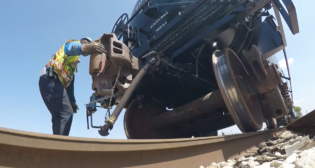
Takeaways from REF 2017: Matt Elkott
Written by William C. Vantuono, Editor-in-ChiefReporting on Rail Equipment Finance 2017, Cowen and Company analyst Matt Elkott notes, “Sentiment is better than last year, but we sensed this is only in small part based on fundamentals and in large part on hope associated with potentially more business-friendly policies and an infrastructure bill. We also noticed a rise in the number of international investors. We continue to believe a material pickup in railcar demand and lease rates is unlikely before late 2017/early 2018.”
“Two private OEMs we spoke with sounded decidedly positive as the marked uptick in inquiries they saw late last year appears to have continued,” Elkott says. “We also sensed that their confidence about this activity translating into orders may have grown somewhat. This is not necessarily in direct contradiction with recent results and commentaries provided by publicly traded peers, but it does seem a little more optimistic.”
Those OEMs are Trinity (TRN) and ARI (ARII). “While TRN had a solid level of orders in 4Q16, it noted on its Feb. 17 conference call that 1Q17 orders to date had been very weak, although that does not mean inquiries were necessarily the same,” Elkott says. “ARII had orders for just 40 cars in 4Q16 but noted that it has received orders for a few hundred cars in 1Q17 and sounded more upbeat than TRN. RAIL (FreightCar America) had orders for only 10 cars in 1Q17 and refrained from commenting on 1Q17 activity. However, we currently see RAIL as an imperfect gauge for the market as it faces some unique challenges in a down cycle.”
GBX (Greenbrier) reported its earnings results much earlier than the rest due to its irregular fiscal year. (See On the road with Greenbrier) “We are encouraged by the insight from the private OEMs but continue to believe that a broad-based rise in demand is unlikely before late 2017/early 2018,” Elkott says. “We continue to have a favorable long-term opinion on GBX and TRN. They are the two most diversified builders, and we believe they are getting closer to annualized trough earnings than many may think.”
As far as demand for specific car types, “we did not hear much that surprised us greatly,” Elkott notes. “The plastic pellet car remains one of the stronger types. Global demand for ethylene is still on the rise, and about 17,000 plastic pellet cars, or roughly 15% of the fleet, are more than 30 years old. However, the risk of overbuilding is very real. About 10,000 cars were built last year and roughly 7,000 are in the backlog. The outlook for frac sand cars has improved (or has gotten less bad); demand for coal cars could see a near-term improvement; and a continued recovery in scrap prices could accelerate scrapping and drive demand for mill gondolas.”
REF 2017 presenters who participate in the scrap market “were positive about 2017 and more positive than they were at last year’s conference, when they correctly predicted a weak 1H16 and a second-half improvement,” Elkott says. “The rise in scrap prices appears to have already triggered some scrapping, and more could occur if the projection for further increases in the commodity price proves accurate. This could eventually lead to a minor shortage of mill gondolas. However, such a shortage may not necessarily lead to new-builds but could aid lease rates.”
Railcar industry production expectations from some speakers and attendees “were a little higher than what we thought we would hear and represented, in at least one case, a slight upward revision,” Elkott says. “We heard a few projections of 40,000 units or more. This is above our expectation of just under 40,000 for 2017.”
Similar to REF 2016, Elkott noticed “a fairly high level of interest by railcar investors and lessors. However, this could be somewhat of a double-edged sword. While it appears there is no shortage of capital looking for a home, including new investors (86 first-time attendees according to one estimate), some industry insiders are concerned that could lead to another wave of overbuilding in higher-demand railcars such as plastic pellets. One indicator of the still high level of interest in the space is the solid conference attendance despite the ongoing and prolonged contraction. We also interacted with a higher number of international investors and lessors than last year.”
Elkott points out that Japanese bank Sumitomo Mitsui is set to buy ARL’s lease fleet for an enterprise value of roughly $97,000/unit, “a rich valuation that may not be indicative of future valuations but may bode well for owners of cars with attached leases.”
Finally, “Some shippers who may have equipment replacement or new demand needs may still be in a self-imposed wait-and-see mode due to factors like macro, political, and policy uncertainty. While the election is behind us, many questions remain about the timing and substance of upcoming legislation.”
“All in all, we felt that sentiment about the industry improved modestly from last year,” Elkott says. “We did not hear much debate about whether or not railcar demand has bottomed. We believe this is due to more stakeholders believing it has. The debate appears to have shifted to whether or not we will see a recovery in the foreseeable future. While more people seemed optimistic in this regard than last year, the range of views still reached outlying extremes, from grim to very positive.”
Editor’s note: The red box in the photo is a Catchbox, a microphone encased in a soft box that is tossed around the conference floor for Q&A. It’s a great time-saver, much faster than the traditional “pass the mike” or open mike in a stationary location. Conference organizaers, take note! Wells Fargo Rail sponsored this at REF 2017.



